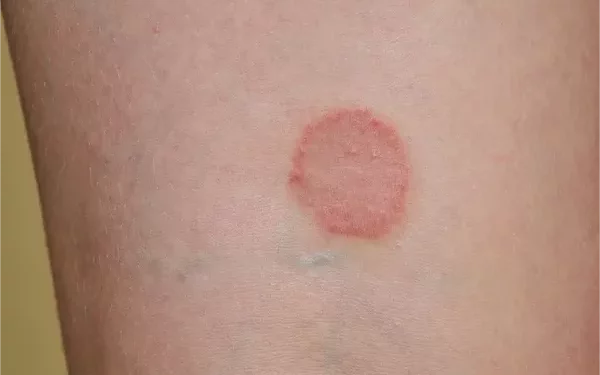Ringworm, also known as tinea, is a common fungal infection that affects the skin, scalp, feet, and nails. It is highly contagious and can spread through a variety of means. Understanding how ringworm is transmitted can help individuals take steps to avoid infection and protect themselves and others. In this article, we will explore how a person catches ringworm, its different transmission methods, and the precautions you can take to prevent it.
What Is Ringworm?
Ringworm is not caused by a worm, despite its name. It is a fungal infection that affects the outer layers of the skin, hair, and nails. The fungus responsible for ringworm belongs to a group called dermatophytes. These fungi thrive in warm, moist environments and can infect humans, animals, and even soil.
The infection often forms a circular or ring-shaped rash, which is why it is called “ringworm.” It can appear on any part of the body, but is most common on the feet (athlete’s foot), scalp, and groin (jock itch). It can also spread to the nails and hands.
How Is Ringworm Spread?
Ringworm is contagious, meaning it can be passed from one person to another through direct or indirect contact. The infection can spread in various ways, making it important to be cautious, especially in environments where the fungus can thrive.
1. Direct Skin-to-Skin Contact
The most common way ringworm is spread is through direct contact with an infected person. When an individual with ringworm touches someone else, the fungus can transfer to the other person’s skin. This often happens during physical activities such as:
- Sports, especially contact sports like wrestling or football
- Hugging or shaking hands with an infected person
- Sharing clothing, towels, or personal items like razors
Ringworm infections can also spread through kissing or sexual contact, as the fungus may be present on the skin or in the groin area.
2. Contact with Infected Animals
Ringworm is common in pets, especially cats and dogs. Animals can carry the fungus on their fur or skin and transfer it to humans. Pets that are infected with ringworm often show signs like:
- Hair loss or bald patches
- Red, scaly skin lesions
- Itchy, inflamed skin
If a person handles an infected pet or touches an area where the animal has been, they can easily contract the fungus. This is why it’s important to ensure pets, especially cats and dogs, are regularly checked by a veterinarian for fungal infections.
3. Fungus in the Environment (Fomites)
Ringworm can also spread through fomites, which are inanimate objects or surfaces that carry the fungus. Common objects that may carry the fungus include:
Towels, blankets, and bedding: If someone with ringworm uses a towel or blanket, the fungus can remain on the fabric and be transferred to others.
Clothing: Wearing clothes that have been contaminated with the fungus, especially tight-fitting clothes or shoes that promote moisture, can increase the risk of infection.
Hairbrushes and combs: If someone uses a brush or comb after someone with ringworm, the infection can spread, especially if the infected person has scalp ringworm.
Shared sporting equipment: Gym mats, balls, or helmets used by athletes can harbor the fungus and spread ringworm if multiple people come into contact with them.
These surfaces can carry the fungi for several hours to days, so it is essential to clean and disinfect commonly shared items.
4. Contaminated Soil
In rare cases, ringworm can be contracted by direct contact with contaminated soil. The fungus can survive in soil for long periods, especially in warm, moist conditions. While this is not as common as the other methods, people who spend time gardening, farming, or playing in soil may be at risk. This is particularly true if the soil contains fungal spores from animals that were infected with ringworm.
5. Public Spaces and Shared Facilities
Ringworm thrives in warm and damp environments. Public places like swimming pools, locker rooms, and showers are ideal breeding grounds for fungi. Individuals who walk barefoot in these areas can easily come into contact with the spores left behind by infected people.
Swimming pools: The moist environment around pools can harbor ringworm spores. Sharing public pools with someone who has an active infection increases the risk of catching ringworm.
Locker rooms and public showers: These areas can be breeding grounds for fungi due to the combination of sweat, moisture, and close contact between individuals. People who walk barefoot or sit on shared benches may be at risk.
Fitness centers: Gym equipment like exercise mats, weight benches, and floors can harbor fungal spores. Not using a towel or mat on these surfaces can increase the likelihood of contracting ringworm.
6. Poor Hygiene and Skin Care Practices
Maintaining personal hygiene is crucial in preventing ringworm. In some cases, poor hygiene can increase the risk of infection. Fungi thrive on dirty, sweaty skin and in areas where moisture accumulates, such as:
Feet: Wearing tight shoes, particularly those made of synthetic materials, can trap moisture and heat, creating a perfect environment for the fungus to thrive.
Groin area: Wearing tight clothing or underwear made of non-breathable fabrics can also lead to fungal growth.
Scalp: Not regularly washing hair or using unclean combs and brushes may allow the fungus to grow and spread.
7. Weakened Immune System
People with weakened immune systems, such as those with HIV/AIDS, diabetes, or cancer, are at a higher risk of contracting ringworm. A weakened immune system is less able to fight off fungal infections, making it easier for the fungus to establish an infection. This is especially true if an individual is already exposed to one of the other transmission methods mentioned above.
Symptoms of Ringworm
The symptoms of ringworm can vary depending on the part of the body affected. Common symptoms include:
Red, itchy patches: The infected area may develop red, circular, scaly patches that are itchy and inflamed.
Bald spots: On the scalp, ringworm can cause hair loss in patches.
Cracked or peeling skin: In some cases, the skin may crack or peel, especially on the feet.
Thickened nails: When the fungus infects the nails, they may become thickened, discolored, and brittle.
How to Prevent Ringworm
Preventing ringworm requires a combination of good hygiene, caution in public spaces, and being mindful of potential sources of infection. Here are some tips to help reduce your risk of catching ringworm:
1. Practice Good Hygiene
- Wash your hands regularly with soap and water.
- Keep your skin clean and dry, especially in areas where moisture can build up (like the feet and groin).
- Shower immediately after exercising or sweating, especially in shared spaces like gyms or pools.
- Don’t share personal items like towels, clothing, or hairbrushes.
2. Avoid Contact with Infected Animals
- Regularly check pets for signs of ringworm and take them to the vet if necessary.
- Avoid direct contact with animals that show signs of fungal infection, and wash your hands after handling them.
3. Disinfect Shared Surfaces and Items
- Disinfect shared equipment in gyms and locker rooms, including mats and benches.
- Always use a clean towel or mat when using public gym equipment.
4. Wear Proper Footwear in Public Places
- Always wear flip-flops or shower shoes in public showers, locker rooms, and around swimming pools.
- Avoid walking barefoot on the floors of these public spaces.
5. Keep Your Environment Clean
- Regularly wash and disinfect bedding, towels, and other items that may come into contact with your skin.
- Keep your living area, especially the bathroom and bedroom, clean and dry.
Conclusion
Ringworm is a contagious fungal infection that can spread through direct contact, contaminated objects, infected animals, and in public spaces. By understanding the ways the infection spreads, you can take steps to avoid getting it. Practicing good hygiene, wearing protective footwear in public spaces, avoiding contact with infected animals, and keeping your environment clean are all effective ways to reduce your risk of catching ringworm. If you suspect you have ringworm, seek treatment promptly to avoid spreading it to others.
Related topics:

























